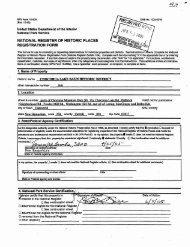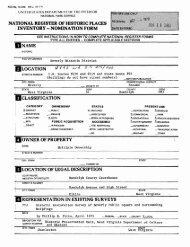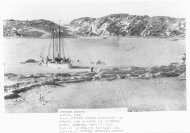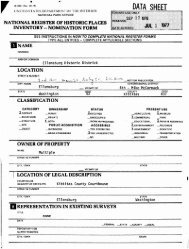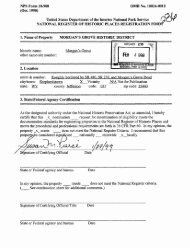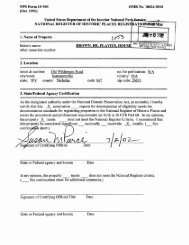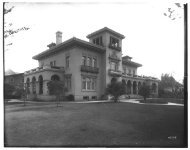National Register of Historic Places Continuation Sheet
National Register of Historic Places Continuation Sheet
National Register of Historic Places Continuation Sheet
You also want an ePaper? Increase the reach of your titles
YUMPU automatically turns print PDFs into web optimized ePapers that Google loves.
NPS Form 10-900-A 0MB Approval No. 1024-0018 (8-86)<br />
United States Department <strong>of</strong> the Interior<br />
<strong>National</strong> Park Service<br />
<strong>National</strong> <strong>Register</strong> <strong>of</strong> <strong>Historic</strong> <strong>Places</strong><br />
<strong>Continuation</strong> <strong>Sheet</strong><br />
Section Number: 8 Page: 1 Geneva-Minnesota <strong>Historic</strong> District, Medford, OR<br />
The Geneva-Minnesota District, an architecturally significant residential neighborhood located in<br />
Medford, Oregon, was first developed in the period between 1911 and 1914, with a second<br />
development phase, focused primarily on Minnesota Street, beginning in 1924. The district has<br />
remained one <strong>of</strong> Medford 1 s prime residential areas and its structures have served as the homes <strong>of</strong> a<br />
wide variety <strong>of</strong> community and business leaders, elected <strong>of</strong>ficials, and others whose actions have<br />
helped shape the city's character during the past 80 years. Retaining almost complete integrity to<br />
its original development and appearance, the Geneva-Minnesota District is a homogenous and<br />
architecturally cohesive neighborhood <strong>of</strong> bungalow, Craftsman, and Period Revival dwellings that<br />
remains one <strong>of</strong> the most intact early 20th century residential areas in the Rogue River Valley.<br />
CONTEXT:<br />
Founded in 1883 with the arrival <strong>of</strong> the railroad to southern Oregon, the city <strong>of</strong> Medford was<br />
developed upon the flat plain lying west <strong>of</strong> Bear Creek. Those lands east <strong>of</strong> the waterway,<br />
originally beyond the city limits, remained prime agricultural lands for the remainder <strong>of</strong> the<br />
century. In the ten years between 1900 and 1910, spurred by a dramatic expansion <strong>of</strong> the region's<br />
orchard industry, Medford's population increased from just over 1700 to almost 9000. This<br />
growth, a gain <strong>of</strong> 392%, not only led all Oregon cities, (and catapulted Medford into position as<br />
the state's fifth largest) but was reported as the second highest growth rate for any city in the<br />
entire United States during the decade. 1<br />
It is not a mere idle assertion that people coming here to locate may<br />
do so without fear <strong>of</strong> over-crowding the place or <strong>of</strong> meeting with<br />
disappointment over the opportunities that the place presents....This<br />
place is fortunate to the point <strong>of</strong> being a phenomenon <strong>of</strong> quick<br />
Oklahoma City, Oklahoma with a percentage increase <strong>of</strong> 395%, was reported as the fasting growing city in<br />
the nation among those that were in existence in 1900, only slightly higher than that <strong>of</strong> Medford. Other<br />
cities, such as Fairbanks, Alaska and Tonopah, Nevada, which had percentage increases many higher than<br />
Medford but were treated as "mining camps" rather than cities since they had existed less than ten years,<br />
(see Medford Mail Tribune 12-January-1912)



